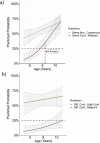Children Use the Relative Confidence of People With Conflicting Perspectives to Form Their Own Beliefs
- PMID: 40396218
- PMCID: PMC12093200
- DOI: 10.1111/desc.70027
Children Use the Relative Confidence of People With Conflicting Perspectives to Form Their Own Beliefs
Abstract
We provide evidence that children sensibly integrate the judgments of different people who disagree according to their confidence. We asked children (ages 5-10 years, N = 92) to make judgments about what happened during unobserved events by relying on two informants who sometimes disagreed. Children integrated the reports of informants and formed novel beliefs endorsed by neither party by 8 years old when the informants reported equal confidence-for example, they selected a monster with six spots when one informant reported seeing one with four spots and another reported seeing one with eight. Unequal confidence across the informants biased children toward the judgment of the more confident party. That children can integrate social confidence judgments with conflicting information-considering and weighing the relative confidence of others to make up their own minds about what is most likely-represents a previously unappreciated mechanism of learning that is crucial to children's development as independent social agents. It allows children to become independent thinkers who can form beliefs that build on the knowledge of others without relying on identical belief adoption of one social agent over another.
Keywords: belief integration; confidence; cue combination.
© 2025 The Author(s). Developmental Science published by John Wiley & Sons Ltd.
Conflict of interest statement
The authors declare no conflicts of interest.
Figures




References
-
- Alais, D. , and Burr D.. 2019. “Cue Combination Within a Bayesian Framework.” In Multisensory Processes, edited by Lee A. K. C., Wallace M. T., Coffin A. B., Popper A. N., and Fay R. R., Vol. 68, 9–31. Springer International Publishing. 10.1007/978-3-030-10461-0_2. - DOI

